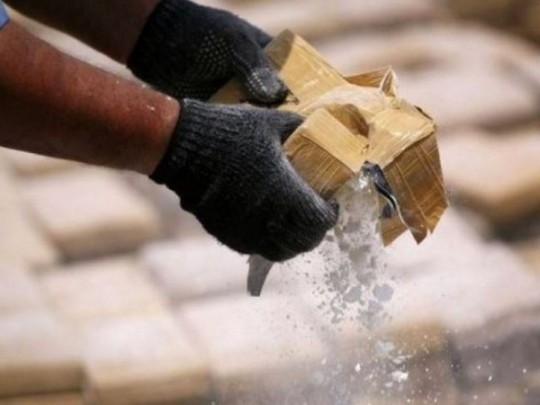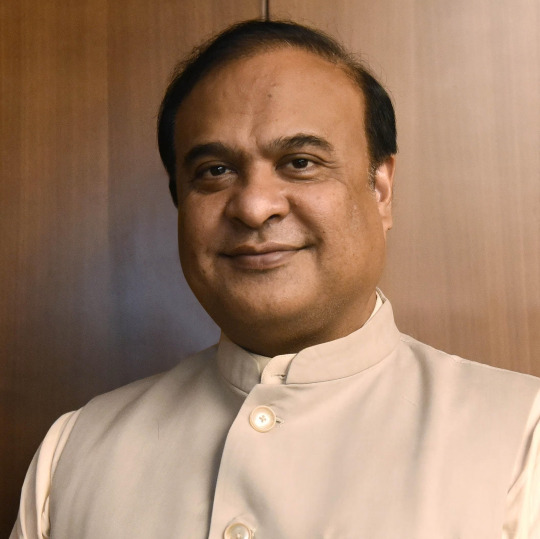#assam chief minister
Explore tagged Tumblr posts
Text
BJP Co-Incharge Himanta Biswa Sarma Visits Jharkhand
Himanta Biswa Sarma Meets Tribal Leaders and Discusses BJP’s Strategy In the aftermath of former Jharkhand Chief Minister Hemant Soren’s release from jail, BJP Co-Incharge and Assam Chief Minister Himanta Biswa Sarma arrived in Jharkhand for a series of crucial meetings. RANCHI – Following the release of former Chief Minister Hemant Soren from jail, BJP Co-Incharge and Assam Chief Minister…

View On WordPress
#Assam Chief Minister#मुख्य#BJP Jharkhand#BJP strategy#Featured#Hemant Soren#Himanta Biswa Sarma#Jamshedpur News#Jharkhand corruption#Jharkhand Politics#Tribal Leaders#Vijay Sankalp Sabha
0 notes
Text
Assam police seized contraband drugs worth 6 CR in karbi anglong, one held
India: July 6 Assam police seized contraband drugs worth around rs 6 CR in a raid at the Assam-Nagaland

1 note
·
View note
Text
Know what is the controversial law AFSPA implemented in Assam since 1990, which Assam CM Himanta Biswa is planning to withdraw
AFSPA can be removed from Assam soon, Assam Chief Minister Himanta Biswa was addressing the Commandant’s Conference on Monday. He said the move would facilitate the deployment of Assam Police battalions in place of the Central Armed Police Forces or CAPFs. AFSPA, the controversial law in force in Assam since 1990, gives security forces the power to crack down and arrest anyone without a warrant.…

View On WordPress
#AFSPA#Assam#Assam Chief Minister#Assam Police battalions#Breaking +65News Near Me#Breaking News#breaking news app#breaking news headlines#breaking news india#breaking news now#CAPF#Central Armed Police Force#CM Himanta Biswa#Controversial law#Exclusive News#india breaking news#International Breaking News#local headlines today#remove AFSPA#Today Breaking News#Trending News
0 notes
Text
President Revamps Governance with Six New Appointments and Three Reshuffles.

New Delhi: According to a press release from Rashtrapati Bhavan, President Droupadi Murmu has announced several new governor appointments and reshuffles.
ALSO READ MORE- https://apacnewsnetwork.com/2024/07/president-revamps-governance-with-six-new-appointments-and-three-reshuffles/
#Assam congressman Ramen Dek#CH Vijayashankar#CP Radhakrishnan#CP Radhakrishnan new governor of Maharashtra#elangana governore#langana's new governor#governor of Assam#governor of Jharkhand#governor of Maharashtra#governor of Punjab#Gulab Chand Kataria#Gulab Chand Kataria governor of Punjab#Gulab Chand Kataria the governor of Punjab#Haribhau Kisanrao Bagde#IAS officer K Kailashnathan#IAS officer K Kailashnathan Lieutenant Governor#Lakshman Prasad Acharya#Lakshman Prasad Acharya governor of Assam#Lakshman Prasad Acharya the governor of Assam#Lieutenant Governor#Lok Sabha MP from Mysore in Karnataka#new governor appointments#new governor of Jharkhand#new governor of Maharashtra#Rajasthan governor#Rajasthan governor Kalraj Mishra#Tripura deputy chief minister Jishnu Dev Varma#Union minister Santosh Kumar Gangwar#Union Territory of Puducherry
0 notes
Text
Himanta Biswa Sarma is an Indian politician and lawyer serving as the 15th and current Chief Minister of Assam since 2021. Himanta Biswa Sarma's age was 32 when he joined politics. Recently news came that he is going to inaugurate Guwahati's Maligaon flyover on August 28.

#biography#celebrities#news#indian celebrities#politician#assam cm#chief minister#indian politics#politicalnews#himanta biswa sarma
0 notes
Text
“Rahul Gandhi tried to defame India in London, but I want to him that 'you will never be able to become the PM until Modi ji is there. Says Assam CM Himanta Biswa
Assam chief minister Himanta Biswa Sarma attacked Congress MP Rahul Gandhi for his London remark. He said that Rahul has been trying to defame India on international platforms as his comments from his speech in London are derogatory. He also said that no matter how hard Rahul tries, he will never be able to become the Prime Minister of India till the time Narendra Modi is there.
Sarma was addressing the Vijay Sankalp rally at Kanakagiri ahead of the upcoming elections, where he said, “We have to bring the Bharatiya Janata Party to power here. We do not need Babri Masjid anymore, we want Ram Janmabhoomi. Rahul Gandhi tried to defame India in London, but I want to him that 'you will never be able to become the PM until Modi ji is there.”
Rahul Gandhi’s democracy remark has rocked the parliament and several MPs are demanding that he apologize for making such derogatory remarks about the country. The debate between Congress apologizing for Rahul’s remarks and BJP offering JPC on the Adani issue is the main topic of the clash in the parliament nowadays.
The second leg of the budget session was abruptly ended by Lok Sabha and Rajya Sabha after there were uproarious scenes and repeated disruptions amid vociferous sloganeering by both treasury benches and opposition members.
Sarma continued to praise Modi while criticizing Rahul for abusing the Indian parliament on foreign soil. “PM Modi is working for the development of Karnataka and the rest of the country. When he travels to London or America, he praises our country. But when Rahul Gandhi visited London, he abused our Parliament,” the Assam CM said at Gangavathi in the Koppal area.
Earlier, Rahul Gandhi, during an interview at Cambridge University said, "Everybody knows, and it has been in the news a lot that Indian democracy is under pressure and attack. I am an Opposition leader in India, we are navigating that (Opposition) space. The institutional framework which is required for a democracy -- Parliament, free press, the judiciary, just the idea of mobilization, moving around -- all are being constrained. So, we are facing an attack on the basic structure of Indian democracy."
For more political news India in Hindi, subscribe to our newsletter.
#werindia#political news India#leading india news source#latest political news#indian politics#political news#rahul gandhi#Assam chief minister Himanta Biswa Sarma#congress#bjp#top news headlines
0 notes
Text
8 notes
·
View notes
Text
ASSAM FLOODS – DISASTER AMID NATURE
Assam, a renowned state with picturesque landscapes, is known for its natural beauty and rich culture. It is home to various hills and mountain ranges, from the Patkai Range to the Khasi Hills, adding to its beauty. The state is also home to the Brahmaputra, one of the largest rivers in the country, popularly known as the "Sorrow of Assam." Describing the river in such a vague term carries significant meaning for many people that most of us tend to overlook. The beauty of the Brahmaputra also brings with it a never-ending array of destruction and sorrow. Each year, the river swells and overflows, leading to widespread floods that wreak havoc across Assam. The floodwaters submerge villages, farmlands, and wildlife sanctuaries, displacing thousands of people and animals. The relentless floods result in the loss of lives, homes, crops, and livestock, leaving behind a trail of devastation.
The human toll of the Assam floods is immense. Thousands of families are forced to evacuate their homes and take refuge in relief camps. The loss of shelter and livelihood plunges them into uncertainty and despair. The floods also disrupt access to clean water, food, and healthcare, exacerbating the suffering of the affected communities. Moreover, it also results in the closing of schools and colleges as they either submerge or are converted into shelters for affected people.
Addressing the issue of Assam floods requires a multifaceted approach. Improving infrastructure, such as building more robust embankments and dams, is crucial. Additionally, implementing effective early warning systems and emergency response plans can help minimize the impact of floods. Sustainable land and water management practices, along with reforestation efforts, can also play a significant role in mitigating the effects of floods.
I cannot say that a lot has been done, but I can surely say that the government can do a lot or has to be done. Both the central and state governments need to take action at the moment to save the beautiful landscape from drowning in the hands of nature. Most of the dams are poorly built, and even though the Chief Minister belongs to the ruling party, the state lacks proper infrastructure in flood-affected areas, with muddy roads and bamboo bridges that fail to stand before the deadly floods.
To quote the 2024 budget, the total receipts other than borrowings and the total expenditure are estimated at ₹32.07 lakh crore and ₹48.21 lakh crore, respectively. The finance Minister announced a comprehensive financial package worth Rs 11,500 crore to bolster flood management initiatives and irrigation projects in various flood-affected states across the nation. We have to wait and see how much of this money actually goes for flood management practices and how much of it goes in the hands of greedy politicians and contractors.“Assam grapples with floods every year by the Brahmaputra River and its tributaries, originating outside India. We will assist Assam in flood management and related projects,” Sitharaman said in her Budget speech in Lok Sabha. The death of thousands is reduced to a mere sentence. Are they being oblivious? They can’t be if we are together.
There are divergent paths that can be taken by the government as well as by people to tackle this age-old problem. The first would be the development of the infrastructure by constructing embankments and dykes. Community preparedness would be a secondary choice if the state had basic infrastructural facilities. The government should also develop and regularly practice community evacuation plans, ensuring everyone knows the safest routes and emergency shelters. For example, in 2022, the Assam State Disaster Management Authority (ASDMA) introduced the "Flood Preparedness Index" to enhance flood management. This tool involves creating scorecards for each district to evaluate disaster preparedness. District disaster management officers manually answer a series of "yes/no" questions to assess administrative compliance with predefined actions required before the monsoon season. While these parameters are essential, they only measure preparedness and do not account for comprehensive data on losses, needs, or vulnerabilities, nor do they consider how these factors vary across districts or contexts or what actions are necessary to mitigate the worst impacts of floods on people.
The Flood Report as of 03-07-2022 stated that 26 districts were affected: Bajali, Barpeta, Biswanath, Cachar, Chirang, Darrang, Dhemaji, Dibrugarh, Dima-Hasao, Goalpara, Golaghat, Hailakandi, Hojai, Kamrup, Kamrup (M), Karimganj, Lakhimpur, Majuli, Morigaon, Nagaon, Nalbari, Sivasagar, Sonitpur, Tamulpur, Tinsukia, Udalguri, Dibrugarh. Rivers flowing above the danger level included Kopili (Dharamtul), Disang (Nanglamuraghat), Burhidihing (Chenimari(Khowang)), and Brahmaputra (Dhubri; Tezpur; Neamatigha). The Assam Flood Report as of 05-08-2024 stated that only three districts – Sivasagar, Golaghat, and Dhemaji – were affected. But in reality, more than three were affected, as there was no mention of my home district, Nagaon, where many old artificial mounds were broken, leading to loss of lives and property.
The International Panel on Climate Change (IPCC) observed in the first installment of its Sixth Assessment Report (AR6) that was released on 9 August 2021 that “…the frequency and intensity of heavy precipitation events have increased since the 1950s over most land areas” and that “human-induced climate change is likely the main driver.” Thus, as climate change tips toward a full-blown crisis, northeast India faces the prospect of more extreme rainfall. The ongoing floods in Assam should be seen as a wake-up call that finally galvanizes action on adaptation. Although engineering solutions such as embankments still have a role to play in mitigating floods, they are no longer sufficient. Nature-based solutions, therefore, have an obvious place in Assam’s flood defense toolbox and provide a powerful complement (or alternative) to engineering solutions. Working alongside engineering solutions, nature-based solutions will boost the overall resilience at all levels of flooding.
The floods of Assam highlight the fragile balance between nature’s beauty and its devastating power. It shows how nature can quench your thirst and drown you simultaneously. Addressing this requires more than just infrastructure; it calls for innovative flood management and community preparedness as well as the voices of the people of this land. As climate change intensifies the challenge, urgent and collaborative action is needed to protect Assam's people and preserve its rich heritage.
2 notes
·
View notes
Text
Can Any Indian Citizen Buy A Property In North East India?

The Modi administration declared significant modifications to legislation in the Union Territory of Jammu and Kashmir on October 26th, using powers provided to the Centre underneath the Jammu and Kashmir Reorganisation Act 2019.
The headline modifications basically allow outsiders to acquire land in J&K by eliminating legislation and statutory rules of the former state that prohibited the ownership of property in J&K to 'permanent inhabitants'.
The lifting of limitations on outsiders purchasing land in J&K has long been hailed by proponents of the Modi government's decision to terminate the former state's special status. Governor Manoj Sinha has lauded the move's industrial ramifications, while BJP politicians like Sambit Patra have enthusiastically declared on social networks that anyone may now buy property in J&K.
Non-tribal people and foreigners are not permitted to purchase land in Sixth Schedule territories, while the Northeast has various state-specific regulations.
As Article 244 of the Indian Constitution, the Sixth Schedule contains provisions for the governance of tribal territories in Assam, Meghalaya, Tripura, and Mizoram.
Mizoram and Nagaland (except Dimapur) are, on the other hand, protected by Articles 371G and 371A of the Indian Constitution, and indigenous people have land ownership rights, and several states in the area have Inner Line Permit (ILP) provisions.
The Sixth Schedule of the Indian Constitution empowers Autonomous District Councils (ADCs) to pass rules prohibiting foreigners from purchasing tribal territory.
Articles 371A for Nagaland and 371G for Mizoram have provided specific authority to refuse any new Acts of Parliament until adopted by a resolution voted by the state's legislative assembly and to defend their rights to their land, customs, and religion.
Inner Line Permit (ILP) is relevant in Mizoram, Nagaland, and Arunachal Pradesh underneath the Bengal Eastern Frontier Regulation of 1873, which requires citizens from other parts of India to obtain permits to enter these states in order to control influx, and outsiders are not permitted to acquire property in the Sixth Schedule and other tribal areas, such as the hills of Manipur.
Prestone Tynsong, Deputy Chief Minister of Meghalaya, stated that there are Sixth Schedule and non-Sixth Schedule territories in Meghalaya.
"There are certain provisions for non-tribal people to acquire land in non-Sixth Schedule regions, including sections of the state capital Shillong as well as some grasslands of the Garo Hills area," Tynsong added.

Assam has several Sixth Schedule regions, and many parts fall underneath the tribal belt, where non-tribal people cannot acquire land. Under the Sixth Schedule of the Indian Constitution, there are three Autonomous Councils: the Bodoland Territorial Council, the Dima Hasao Autonomous District Council, and the Karbi Anglong Autonomous District Council.
Aside from these, Assam has 17 tribal straps and 30 blocks in the districts of Morigaon, Tinsukia, Darrang, Sonitpur, Nagaon, Lakhimpur, Kamrup, Goalpara, Dhemaji, and Bongaigaon, and four districts under the Bodoland Territorial Council (BTC) where non-tribals are prohibited from purchasing land.
#North East India#real estate#buy property#home buying#house buying#citizen#indian citizen buy property in north india
2 notes
·
View notes
Text
Rahul Gandhi’s speech: From China inside Indian territory to Make in India ’failed’ jibe — Top quotes
Rahul Gandhi, the Leader of the Opposition and Congress leader, launched a scathing attack on Prime Minister Narendra Modi government over a host of issues related to Artificial Intelligence, Election Commission data, selection of Election Commissioners and China’s alleged transgression into India. Gandhi’s remarks drew criticism from Bharatiya Janata Party (BJP) leaders. Assam Chief Minister…
0 notes
Text
[ad_1] Assam Chief Minister Himanta Biswa Sarma launched a scathing attack on former Delhi Chief Minister Arvind Kejriwal during an election rally in the Adarsh Nagar Assembly constituency. CM Sarma criticised AAP convenor Kejriwal for his past promise to clean the Yamuna River, saying, Read More [ad_2] Source link
0 notes
Text
जानिए क्या है 1990 से असम में लागु AFSPA, जिसे वापस लेने का प्लान बना रहे असम के सीएम
1990 से असम में लागु विवादास्पद कानून AFSPA सुरक्षा बलों को कार्रवाई करने और बिना वारंट के किसी को भी गिरफ्तार करने का अधिकार देता है। इसके अलावा, किसी की गोली मारकर हत्या कर देने पर यह कानून सुरक्षा बलों को गिरफ्तारी और मुकदमे से छूट देता है। असम को नवंबर, 1990 में AFSPA के तहत अशांत क्षेत्र घोषित किया गया था। तभी से इसे हर छह महीने में बढ़ाया जाता रहा है। मुख्यमंत्री सरमा सोमवार को कमांडेंट…

View On WordPress
#AFSPA#Assam#Assam Chief Minister#Assam Police battalions#Breaking News#breaking news app#breaking news headlines#breaking news india#breaking news now#CAPF#Central Armed Police Force#CM Himanta Biswa#Controversial law#Exclusive News#india breaking news#International Breaking News#local headlines today#remove AFSPA#Today Breaking News#Trending News
0 notes
Text
[ad_1] Assam Chief Minister Himanta Biswa Sarma launched a scathing attack on former Delhi Chief Minister Arvind Kejriwal during an election rally in the Adarsh Nagar Assembly constituency. CM Sarma criticised AAP convenor Kejriwal for his past promise to clean the Yamuna River, saying, Read More [ad_2] Source link
0 notes